Learning Objectives
At the end of this module, you will be able to
- List the characteristics of an open educational resource (OER)
- Discuss the benefits of open
- Compare different open licenses
What is open?
When something is described as “open”, it means that it has been made available with little to no restrictions for other people to access or use. Open can also describe practices, means, and methods that support the idea that knowledge and learning should be available to everyone by reducing barriers to share, access, and use.
Open Education encompasses resources, tools and practices that are free of legal, financial and technical barriers and can be fully used, shared and adapted in the digital environment. Open Education maximizes the power of the Internet to make education more affordable, accessible and effective.
– SPARC
An educational resource can be more or less open depending on what people are allowed to do with it. There are 5 core activities (5Rs) that people use open educational resources (OERs) for:
- Retain – make, own, and control a copy of the resource (e.g., download and keep your own copy)
- Revise – edit, adapt, and modify your copy of the resource (e.g., translate into another language)
- Remix – combine your original or revised copy of the resource with other existing material to create something new (e.g., make a mashup)
- Reuse – use your original, revised, or remixed copy of the resource publicly (e.g., on a website, in a presentation, in a class)
- Redistribute – share copies of your original, revised, or remixed copy of the resource with others (e.g., post a copy online or give one to a friend)
The ability for people to use an OER in any of these ways will be determined by what license the creator has chosen to put on the object.
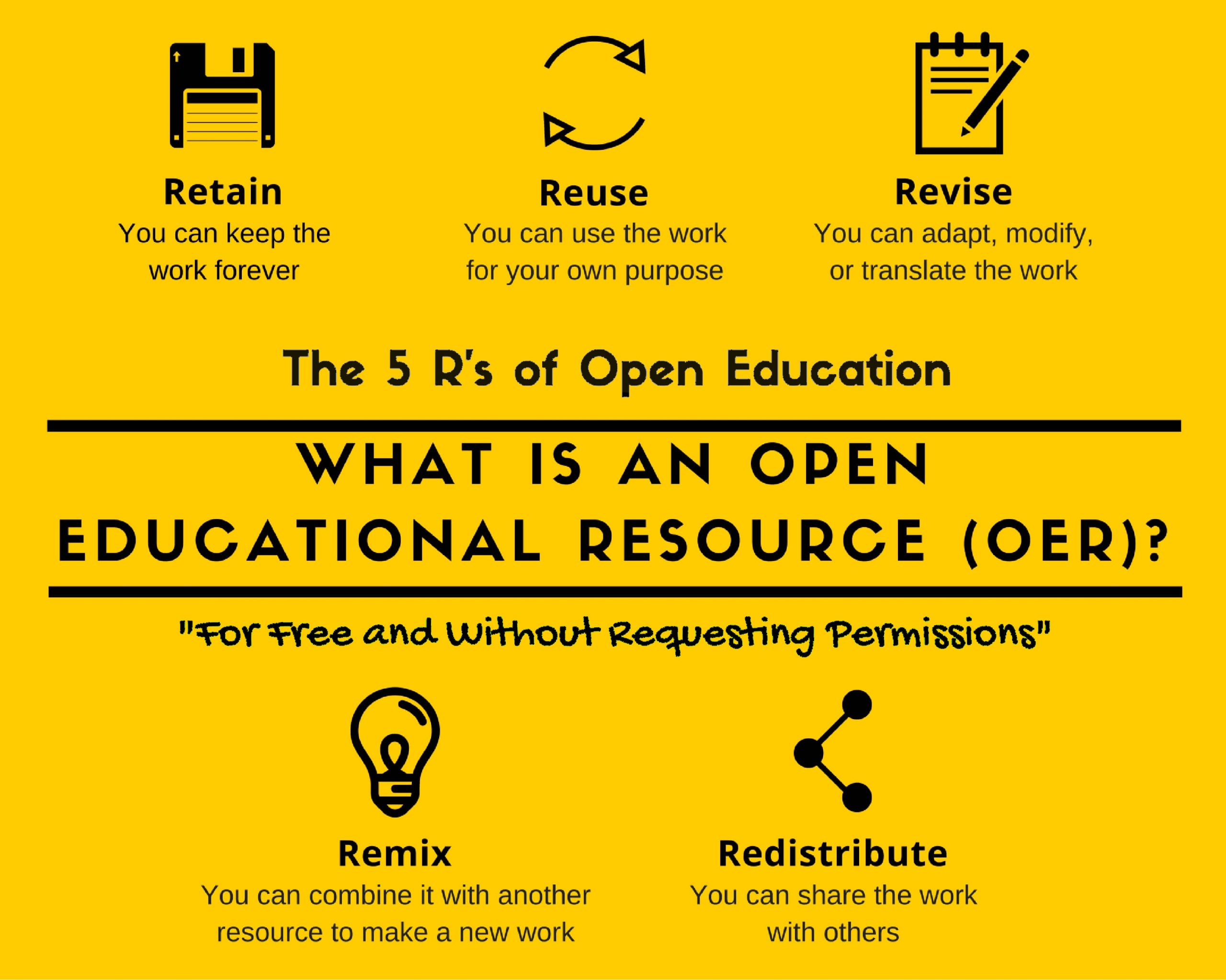
Take a moment
Do you already participate in some of these activities?
Why is open valuable?
One of the driving factors for the adoption of OER, such as open textbooks, is they are free. But cost savings is not the only benefit of using OER – they are an essential part of open pedagogy and can be used to create a powerful learning experience for your students. Studies have revealed a “positive relationship between the use of OER and student academic achievement” [PDF] and suggest that OER may help to decrease withdrawal rates while increasing overall student grades.
OER can:
- Increase access to education
- Provide students with an opportunity to assess and plan their education choices
- Showcase an institution’s intellectual outputs, promote its profile, and attract students
- Convert students exploring options into fee paying enrollments
- Accelerate learning by providing educational resources for just-in-time, direct, informal use by both students and self-directed learners
- Add value to knowledge production
- Reduce faculty preparation time
- Save students a significant amount of cost – (this case has been particularly substantiated for open textbooks)
- Enhance quality
- Generate innovation through collaboration
Take a moment
Licensing
Licensing plays a big role in open because it determines the extent that learning objects can be used in 5R activities. All creators automatically have copyright over their created works which gives creators the right to control how their material is used. Upon creation, creators can choose to give their work an open license which indicates to others that the work can be used under certain conditions. These licenses do not remove or replace copyright, but they allow others to legally use, share, remix, or repurpose the work. The most common open licenses to use are Creative Commons licenses.
Creative Commons
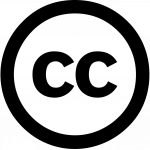 Creators or copyright holders who wish to apply a Creative Commons license to their work can choose to allow their work to be copied and reused with any one or more restrictions, or certain combinations of restrictions. The four restrictions are:
Creators or copyright holders who wish to apply a Creative Commons license to their work can choose to allow their work to be copied and reused with any one or more restrictions, or certain combinations of restrictions. The four restrictions are:
| Icon | Option | Restriction |
 |
Attribution
|
You must give appropriate credit, provide a link to the license, and indicate if changes were made. You may do so in any reasonable manner, but not in any way that suggests the licensor endorses you or your use. |
 |
Share Alike
|
If you remix, transform, or build upon the material, you must distribute your contributions under the same license as the original. |
 |
Non Commercial
|
You may not use the material for commercial purposes. |
 |
No Derivatives
|
If you remix, transform, or build upon the material, you may not distribute the modified material.
|
These four restrictions can be mixed and matched to form six different Creative Commons licenses. All Creative Commons licenses require attribution. The specific types of Creative Commons licenses are:
| Image | License | Description |
 |
CC-BY Attribution |
This license lets others distribute, remix, tweak, and build upon the work as long as they credit the creator for the original creation. This is the most flexible and accommodating of the available Creative Commons licenses.
|
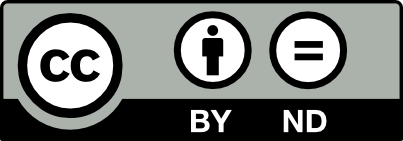 |
CC-BY-ND Attribution-NoDerivs |
This license allows for redistribution, commercial and non-commercial, as long as the licensed work is passed along unchanged and in whole, with credit to the creator.
|
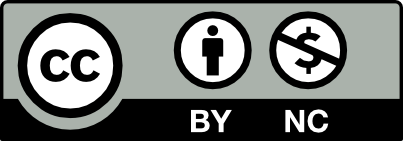 |
CC BY-NC Attribution-NonCommercial |
This license lets others remix, tweak, and build upon the work non-commercially.
|
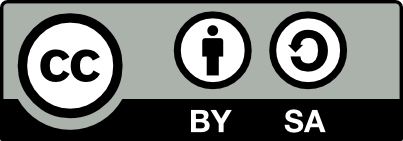 |
CC BY-SA Attribution-ShareAlike |
This license lets others remix, tweak, and build upon the work as long as they credit the creator and license all new creations under the identical terms. All new works based on yours will carry the same license.
|
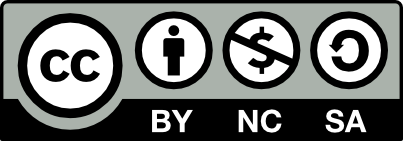 |
CC BY-NC-SA Attribution-NonCommercial-ShareAlike |
This license lets others remix, tweak, and build upon your work non-commercially, as long as they credit the creator and license their new creations under the identical terms.
|
 |
CC BY-NC-ND Attribution-NonCommercial-NoDerivs |
This license is the most restrictive of the six main licenses, only allowing others to download your works and share them with others as long as they credit the creator, but they can’t change them in any way or use them commercially.
|
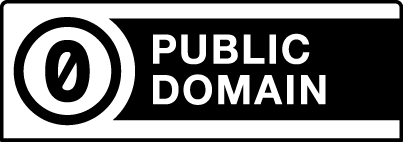 |
CC0 CC Zero |
CC0 is a public dedication tool, which allows creators to give up their copyright and put their works into the worldwide public domain. CC0 allows reusers to distribute, remix, adapt, and build upon the material in any medium or format, with no conditions.
|
Take a moment
Module quiz
Test your knowledge about the basic concepts of Open and Creative Commons Licensing
Summary
Adaptation statements
This module adapted content from:
- What are Open Educational Resources? by BCcampus OpenEd, CC-BY
- Share Your Work by Creative Commons, CC-BY
Media Attributions
- What is an OER © MSU Libraries adapted by Open BCIT is licensed under a CC BY (Attribution) license

